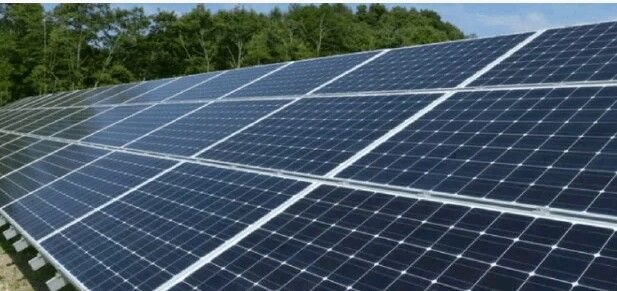Photovoltaic cells utilize the energy of the sunlight to produce electricity. Direct current (DC) is generated from stationary solar panels (which are made up of photovoltaic cells) and is commonly used for local applications, includingrunning small-scale irrigation pumps or to charge battery-powered devices. Commercial scale solar power plants are steadily gaining popularity withthe increase in the price of fossil fuels. They function by trapping solar energy through large reflectors. The trapped energy is then directed onto receivers that use various technologies to generate electricity by powering gas or steam turbines. The Nellis Power Plant is the largest solarpower plant in North America. It is located in the Nellis Air Force Base in Clark County, Nevada, near Las Vegas. The plant is made up of more than 70,000 photovoltaic solar panels and its maximum electrical capacity is estimatedat 13 mega watts of alternatingcurrent (13 MW A

As shown in the picture below, a solar panel (or module) is a group of cells connected electronically and grouped into a frame. Many modules are put together to form a solar array and many arrays connected together form a solar system. You can find basic information about solar panels in the Ultimate Guide to Solar Panels .
Solar cells, or photovoltaic (PV) cells, convert
sunlight directly into electricity . Solar cells are connected electronically and packed together in a frame, commonly known as a solar panel. Solar cells are made of semiconductors such as silicon, which absorb the sunlight and convert it into electricity.
The electrical conductors are attached to positive and negative terminals, thus forming an electrical circuit. From there the electrons can be captured in the form of an electric current (electricity). This current, together with the cell's voltage (which is a result of its built-in electric field or fields), defines the power (or wattage) that the solar cell can produce.
There are stand-alone PV systems and grid-connected PV systems. What makes them different is that in the first case solar energy is stored for personal use, whilst in a grid-connected solar system you can sell your surplus of electricity back to the grid.
What might be surprising is that solar panels
do not need direct sunlight to work . Although efficiency is boosted on sunny days, solar panels also produce a considerable amount of electricity on cloudy days and during the winter season. The chart below shows how much energy is gathered by solar panels throughout the year (with solar panels facing south and a 3kWp system). The power of PV solar panels is measured in kilowatts peak (kWp).
A typical commercial solar module has an
efficiency of 16.5% , meaning that over one-sixth of the sunlight hitting the module is converted into electricity. One important challenge of the PV industry is to improve solar module efficiency, and at the same time, keep down the cost per cell.How Do Solar Panels Work?
As shown in the picture below, a solar panel (or module) is a group of cells connected electronically and grouped into a frame. Many modules are put together to form a solar array and many arrays connected together form a solar system. You can find basic information about solar panels in the Ultimate Guide to Solar Panels .
Solar cells, or photovoltaic (PV) cells, convert
sunlight directly into electricity . Solar cells are connected electronically and packed together in a frame, commonly known as a solar panel. Solar cells are made of semiconductors such as silicon, which absorb the sunlight and convert it into electricity.
The electrical conductors are attached to positive and negative terminals, thus forming an electrical circuit. From there the electrons can be captured in the form of an electric current (electricity). This current, together with the cell's voltage (which is a result of its built-in electric field or fields), defines the power (or wattage) that the solar cell can produce.
There are stand-alone PV systems and grid-connected PV systems. What makes them different is that in the first case solar energy is stored for personal use, whilst in a grid-connected solar system you can sell your surplus of electricity back to the grid.
What might be surprising is that solar panels
do not need direct sunlight to work . Although efficiency is boosted on sunny days, solar panels also produce a considerable amount of electricity on cloudy days and during the winter season. The chart below shows how much energy is gathered by solar panels throughout the year (with solar panels facing south and a 3kWp system). The power of PV solar panels is measured in kilowatts peak (kWp).
A typical commercial solar module has an
efficiency of 16.5% , meaning that over one-sixth of the sunlight hitting the module is converted into electricity. One important challenge of the PV industry is to improve solar module efficiency, and at the same time, keep down the cost per cell.

Good job 👍
thanks